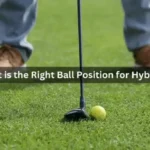Golf simulators have become increasingly popular among both amateurs and professionals. They’re a cool way to play and practice golf anytime, no matter if it’s raining outside or you only have a little bit of time. But a question that often arises is: how accurate are golf simulators? how accurate are golf simulators
Let’s look into how accurate they really are, the tech that makes them work, which golf simulators are the most accurate, and what affects how precise they can be. This way, we can really understand what’s going on with them.
The Accuracy Range of Golf Simulators
Today’s golf simulators are pretty spot-on, with their accuracy usually falling between 85-90% to even more than 95%. This makes them really helpful for getting better at golf, whether that’s working on your technique, planning your plays, or just understanding your game better. But, how accurate a simulator can be depends on a few things like the kind of tech it uses, how good the launch monitor is (that’s the gadget that tracks the ball), the settings in the software, and how it’s all set up.

Types of Golf Simulators and Their Technologies
Golf simulators use cool tech to bring the game of golf inside, so you can play and practice anytime, no matter the weather. How close they get to feeling like the real deal depends on the type of technology they use. Let’s dive into how this tech works and how it helps make some simulators more accurate than others.
Camera-Based Systems
How They Improve Accuracy:
These systems are super precise in tracking how the ball flies and spins because they use high-speed cameras to watch the ball right when it’s hit. They can exactly measure how fast the ball is going, its angle when it leaves the club, and where it’s headed, giving players detailed info to help them get better.
Tech Behind It:
They rely on high-speed cameras that can take thousands of pictures every second. This lets them closely analyze the ball’s flight and how the club moves when it hits the ball.
Infrared Systems
How They Improve Accuracy:
Infrared systems are really consistent inside because they use infrared light to keep an eye on both the club and ball. They’re great at ignoring changes in lighting, so you get reliable data no matter where you set it up.
Tech Behind It:
These systems use a bunch of infrared sensors and lights to make an invisible grid. When the ball and club go through this grid, the system grabs all sorts of data like speed, angle, and spin.
Radar Systems
How They Improve Accuracy:
Radar systems give you a ton of info on how the ball flies, like how far it goes, its speed, and its path, by using Doppler radar. They’re super accurate outside and are a top choice for pros who want a deep dive into their game.
Tech Behind It:
Doppler radar is used here to send out signals that bounce back from the moving ball and club. This helps in measuring their speed, direction, and lots of other important stuff really accurately.

Which Golf Simulators Are the Most Accurate?
Picking a really accurate golf simulator is key to making your golf practice better and more like playing on a real course. It’s super important that these simulators can mimic how golf really works, with all its tiny details. Let’s look at the top-notch golf simulators out there that are famous for getting it just right. Using one of these can really up your game.
Top Accurate Golf Simulators
TrackMan
- How It Works: Uses Doppler radar to keep a close eye on both the golf ball and how the club moves.
- Why It’s Great: It’s super accurate, which is why pros use it a lot for practice, coaching, and getting their gear just right. It gives detailed info that can really help improve your swing and how you understand the way the ball flies.
Foresight Sports GCQuad
- How It Works: Has four high-speed cameras to catch all the details about the ball and club.
- Why It’s Great: It gives super precise readings, perfect for both inside and outside. It’s great for getting a deep dive into every part of your swing and how the ball moves, making it a favorite for coaching and fitting golf equipment.
SkyTrak
- How It Works: Captures images of the ball right after you hit it, using photometric tech.
- Why It’s Great: Strikes a sweet spot between being really accurate and not breaking the bank, which is awesome for serious golfers who want to practice at home. Plus, it’s easy to move around, so you can set it up how you like.
Full Swing Simulators
- How It Works: Combines fast cameras and infrared to get all the motion details.
- Why It’s Great: Even PGA pros are fans. They have different models for all sorts of spaces, from businesses to your living room, all without skimping on how accurate they are.
AboutGolf
- How It Works: Uses 3Trak tech with speedy cameras for spot-on data.
- Why It’s Great: It’s all about giving you a super realistic golfing vibe that feels just like the real deal, popular in both business places and fancy home setups.
Tips to Make Golf Simulations More Accurate
- Pick a Good Launch Monitor: Go for a top-notch launch monitor, such as the Foresight GC Quad or TrackMan. These devices give you detailed info about how the ball flies and how you swing.
- Set It Up Right: Make sure all the sensors and cameras are set up perfectly, pointing in the right direction, and that the place where you hit the ball feels like you’re out on a real golf course.
- Use Powerful Computers: The simulator needs a strong computer that can handle complex calculations and show what’s happening accurately and smoothly.
- Make the Environment Ideal: Keep the lighting consistent and reduce any distractions or things that could mess with the sensors, to make sure your simulator can do its job as accurately as possible.
The Cost Factor: Does More Expensive Mean More Accurate?
When it comes to golf simulators, a common question is whether a higher price tag guarantees better accuracy. The market offers a wide range of options, from budget-friendly setups to high-end systems, with costs that can range from a few hundred dollars to over $20,000. This price variation reflects differences in technology, features, and, importantly, accuracy levels. Understanding how cost influences accuracy and what you get at different price points can help make an informed purchase decision.
Price Ranges and Expected Accuracy Levels
Budget to Mid-Range Simulators
- Cost: Under $2,000 to $10,000.
- Accuracy Level: These simulators typically use photometric or infrared technologies and offer decent accuracy. They can accurately track basic ball flight data like speed, angle, and distance but may not capture the full spectrum of dynamics involved in a golf swing.
- Consideration: Ideal for casual golfers or those looking to enjoy golf indoors without a significant investment.
High-End Simulators
- Cost: $10,000 to over $20,000.
- Accuracy Level: Utilizing advanced radar systems or high-speed camera setups, high-end simulators offer superior accuracy. They can provide detailed analytics on ball spin, launch angle, speed, and more, closely replicating real-life conditions.
- Consideration: Preferred by professionals and serious golfers who demand the most realistic and detailed feedback for training and improvement.
Highlighting Examples of High-End Simulators
- Foresight GC Quad: Cost typically ranges from $14,000 to $18,000. It employs four high-speed cameras to deliver comprehensive ball and club data, leading to highly accurate readings. It’s popular for its precision and versatility in both indoor and outdoor settings.
- TrackMan: Cost can exceed $20,000 for the latest models. Renowned for its Doppler radar technology, TrackMan provides exhaustive data on ball flight and swing, making it a staple in professional training setups.
FAQS
Q: How accurate are golf simulators?
A: Golf simulators can be highly accurate, with some of the top-end models achieving close to real-life accuracy in simulating ball flight, spin, launch angle, and distance. The accuracy largely depends on the technology used, such as infrared sensors, high-speed cameras, or radar. High-quality simulators can achieve accuracy within a few yards of actual shot results.
Q: Do golf simulators accurately measure all types of shots?
A: Yes, most advanced golf simulators can accurately measure a wide range of shots, including drives, iron shots, pitches, chips, and putts. However, the level of accuracy can vary for different types of shots. For instance, simulating short game shots and putts can be more challenging and might not always match the accuracy of longer shots.
Q: Can golf simulators improve my game?
A: Absolutely. Golf simulators can be an excellent tool for practice and improvement, offering instant feedback on each shot. They provide detailed data on swing path, ball speed, launch angle, spin rates, and more, which can be invaluable for identifying and correcting flaws in your game.
Q: Are there differences in accuracy among different brands and models?
A: Yes, there is a significant variance in accuracy among different brands and models of golf simulators. High-end models from reputable manufacturers tend to offer higher accuracy and more realistic simulation experiences compared to entry-level models. The technology used for tracking and simulation plays a crucial role in determining the accuracy.
Q: How do environmental factors affect accuracy in golf simulators?
A: In a controlled indoor environment, external factors like wind, temperature, and humidity have no direct impact on the simulation. However, some simulators allow users to manually adjust settings to simulate these conditions for a more realistic experience. The quality of the simulation software also affects how well these factors are replicated.







